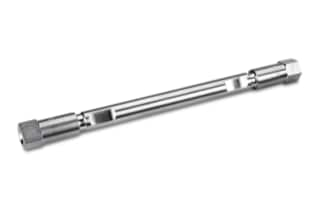
|
Chemistry |
C18 |
|
Separation Mode |
Reversed Phase |
|
Particle Substrate |
Silica |
|
pH Range Min |
2 pH |
|
pH Range Max |
8 pH |
|
Temperature Limits |
45 C |
|
Maximum Pressure |
6000 psi (415 Bar) |
|
Endcapped |
Yes |
|
Bonding Technology |
T3 |
|
Silanol Activity |
Medium |
|
Particle Shape |
Spherical |
|
Particle Size |
3.5 µm |
|
Endfitting Type |
Waters |
|
Pore Size |
100 Å |
|
Format |
Column |
|
Surface Area |
230 |
|
System |
HPLC |
|
Particle Technology |
HSS |
|
USP Classification |
L1 |
|
Inner Diameter |
3 mm |
|
Length |
100 mm |
|
Carbon Load |
11 % |
|
UNSPSC |
41115709 |
|
Brand |
XSelect |
|
Product Type |
Columns |
|
Units per Package |
1 pk |

XSelect HSS T3 Column, 100Å, 3.5 µm, 3 mm X 100 mm, 1/pk
HSS Technology refers to the High Strength Silica Technology produced by Waters on which this particular XSelect HSS T3 Column is designed. The HSS Technology was carefully designed to complement chromatographic performance and scalability of BEH (Ethylene Bridged Hybrid) and CSH (Charged Surface Hybrid) particles. It enables the column to provide unique and distinct advantages in contrast to other columns in the same space. The embedded technology within the XSelect HSS T3 Column offers higher silanophilicity that yields increased polar retention and selectivity in analysis.
The applications of the XSelect HSS T3 Columns are numerous, and we highly recommend it be considered for applications where you would be looking to develop separations for polar and nonpolar compounds. The XSelect HSS T3 Column contains a low-coverage C18 phase designed to be compatible with 100% aqueous mobile phase. The features of the XSelect HSS T3 Column enable it to have ultra-low MS bleed and be fully scalable and transferable to UPLC separations.
The XSelect HSS T3 Column is designed to provide you with supreme reproducibility and transferability. The lab equipment possesses the chemical and physical characteristics for seamless scalability, and these characteristics will enable you to achieve higher resolution separations that are required for complex samples in order to isolate and quantify the unique constituents. It combines efficiency and selectivity to enhance the resolution of very complex samples.
With the addition of the ‘right fit’ lab equipment, you can significantly increase your productivity. To learn more about the variations of additional XSelect products and additional offerings from Waters that work with them, please check out our shop for lab equipment; you can browse through our website, refer to our catalog and ensure your lab needs are met as needed.
You may also want to look into our Reversed-Phase QC Reference Material; it is a unique collection of standards and mixtures. Specifically designed to provide this complexity and is appropriate when complex assays are routinely performed. It can be used with a variety of column chemistries, dimensions, and system hardware. It contains 7 compounds, including uracil, butylparaben, naphthalene, propranolol, dipropyl-phthalate, acenaphthene, and amitriptyline at pH 7.
What Can Be The Impact Of Polarity On Separation In Chromatography?
Polar molecules are more strongly attracted to polar solvents and so move further if a polar solvent is used as opposed to a nonpolar solvent. The distance that spots move can be compared to the overall distance the solvent has moved and comparisons and measurements made.